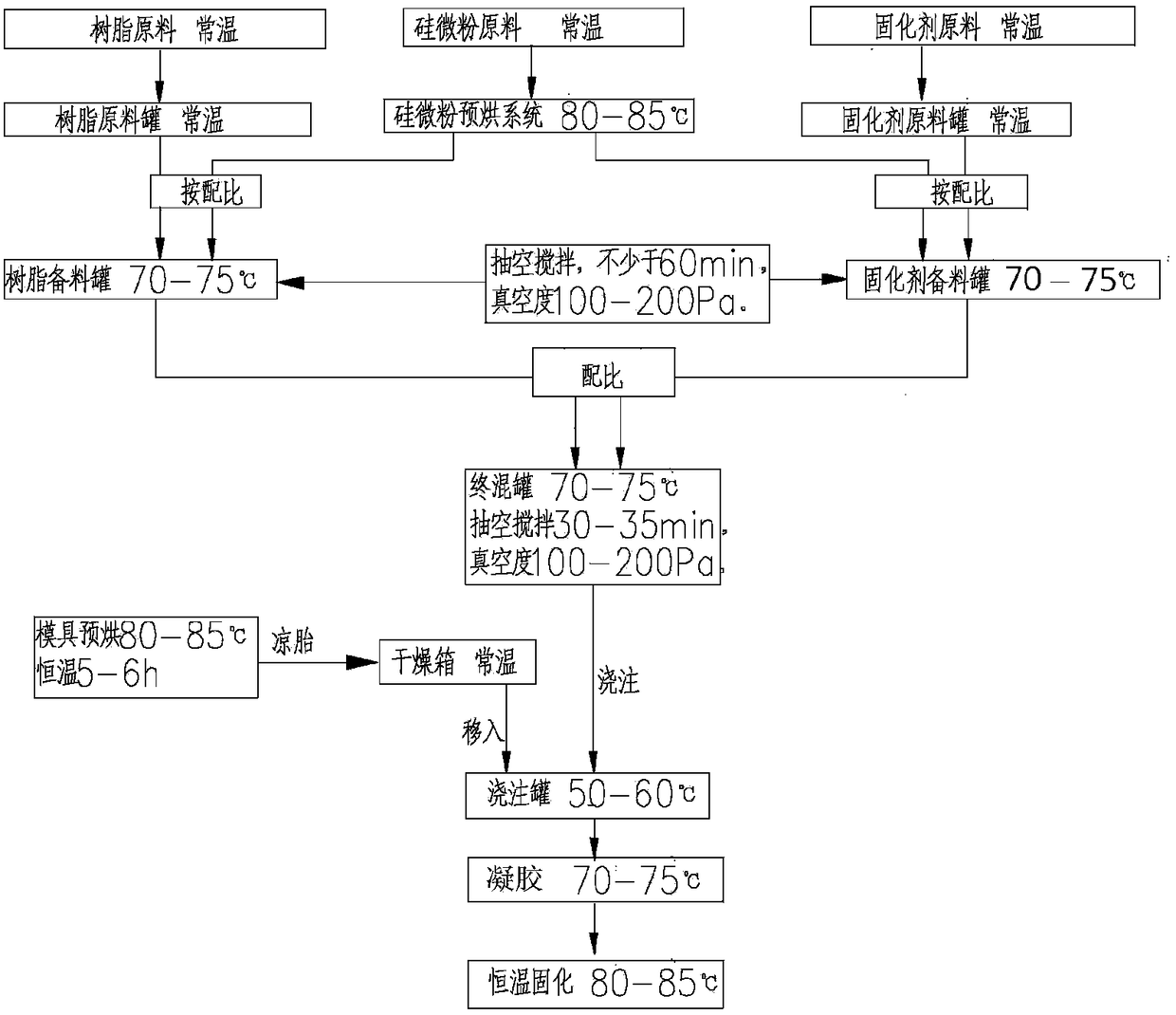Vacuum pouring and gelating method for epoxy resin
An epoxy resin and vacuum casting technology, which is applied in household components, applications, encapsulation/impregnation, etc., can solve problems such as unsatisfactory high-voltage electrical insulation devices, single control method, and imperfect process
- Summary
- Abstract
- Description
- Claims
- Application Information
AI Technical Summary
Problems solved by technology
Method used
Image
Examples
Embodiment 1
[0043] (1) Pre-bake the 400-mesh microsilica filler to 80°C in the pre-baking system, pre-dry 100 parts of epoxy resin at room temperature and 200 parts of 80°C microsilica filler in a resin stock tank with a vacuum of 150Pa at 70°C. Mix to obtain premix 1; in addition, pre-mix 75 parts of room temperature curing agent and 150 parts of 400-mesh silica powder filler at 80°C in another curing agent stock tank with a vacuum of 140Pa at 70°C to obtain premix 2; These two premixing processes are carried out simultaneously in two different material preparation tanks, and the evacuation and stirring time is 90 minutes; the premixes 1 and 2 prepared in the previous two parts are put into the same vacuum final mixing tank for final mixing, Stirring at 73° C. and vacuum degree of 150 Pa for 35 minutes to obtain the final mixture, the temperature of the final mixture is 75° C.
[0044] (2) Pre-bake the mold at a constant temperature of 85°C for 5.5 hours, and then move it into a normal t...
Embodiment 2
[0048] (1) Pre-bake the 400-mesh silicon micropowder filler in the pre-baking system to 82°C, and put 100 parts of epoxy resin at room temperature and 200 parts of 400-mesh silicon micropowder filler at 82°C in a vacuumized 120Pa resin stock tank at 70°C. Premix to obtain premix 1; in addition, premix 75 parts of room temperature curing agent and 150 parts of 400-mesh silicon micropowder filler at 82°C in another vacuum 120Pa curing agent stock tank at 70°C to obtain premix 2; These two premixing processes are carried out simultaneously in two different material preparation tanks, and the evacuation and stirring time is 60 minutes; the premixes 1 and 2 prepared in the previous two parts are put into the same vacuum final mixing tank for final mixing, Stir for 35 minutes at 70° C. and a vacuum of 120 Pa to obtain the final mixture, and the temperature of the final mixture is 70° C.
[0049] (2) Pre-bake the mold at a constant temperature of 85°C for 5 hours, and then move it in...
Embodiment 3
[0053] (1) Pre-dry the 400-mesh silicon micropowder filler in the pre-baking system to 85°C, put 100 parts of epoxy resin at room temperature and 200 parts of 400-mesh silicon micropowder filler at 85°C in a resin preparation tank with a vacuum of 200Pa at 75°C ℃ to pre-mix to obtain premix 1; in addition, 75 parts of normal temperature curing agent and 150 parts of 400 mesh silica powder filler at 85 ℃ were pre-mixed at 70 ℃ in another curing agent stock tank with a vacuum of 200 Pa to obtain premix Material 2; these two premixing processes are carried out simultaneously in two different material preparation tanks, and the evacuation and stirring time is 120min; the premixes 1 and 2 prepared in the previous two parts are put into the same vacuum final mixing tank. Finally, mix and stir at 75° C. and a vacuum of 200 Pa for 30 minutes to obtain the final mixture. The temperature of the final mixture is 75° C.
[0054] (2) Pre-bake the mold at a constant temperature of 80°C for ...
PUM
| Property | Measurement | Unit |
|---|---|---|
| Electric strength | aaaaa | aaaaa |
| Tensile strength | aaaaa | aaaaa |
| Electric strength | aaaaa | aaaaa |
Abstract
Description
Claims
Application Information
 Login to View More
Login to View More - Generate Ideas
- Intellectual Property
- Life Sciences
- Materials
- Tech Scout
- Unparalleled Data Quality
- Higher Quality Content
- 60% Fewer Hallucinations
Browse by: Latest US Patents, China's latest patents, Technical Efficacy Thesaurus, Application Domain, Technology Topic, Popular Technical Reports.
© 2025 PatSnap. All rights reserved.Legal|Privacy policy|Modern Slavery Act Transparency Statement|Sitemap|About US| Contact US: help@patsnap.com

